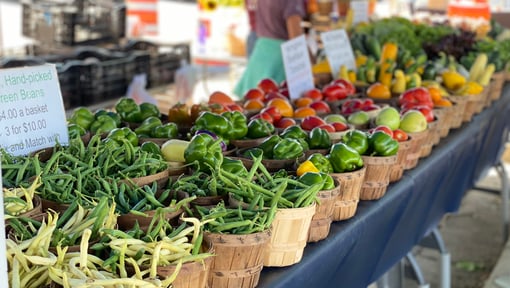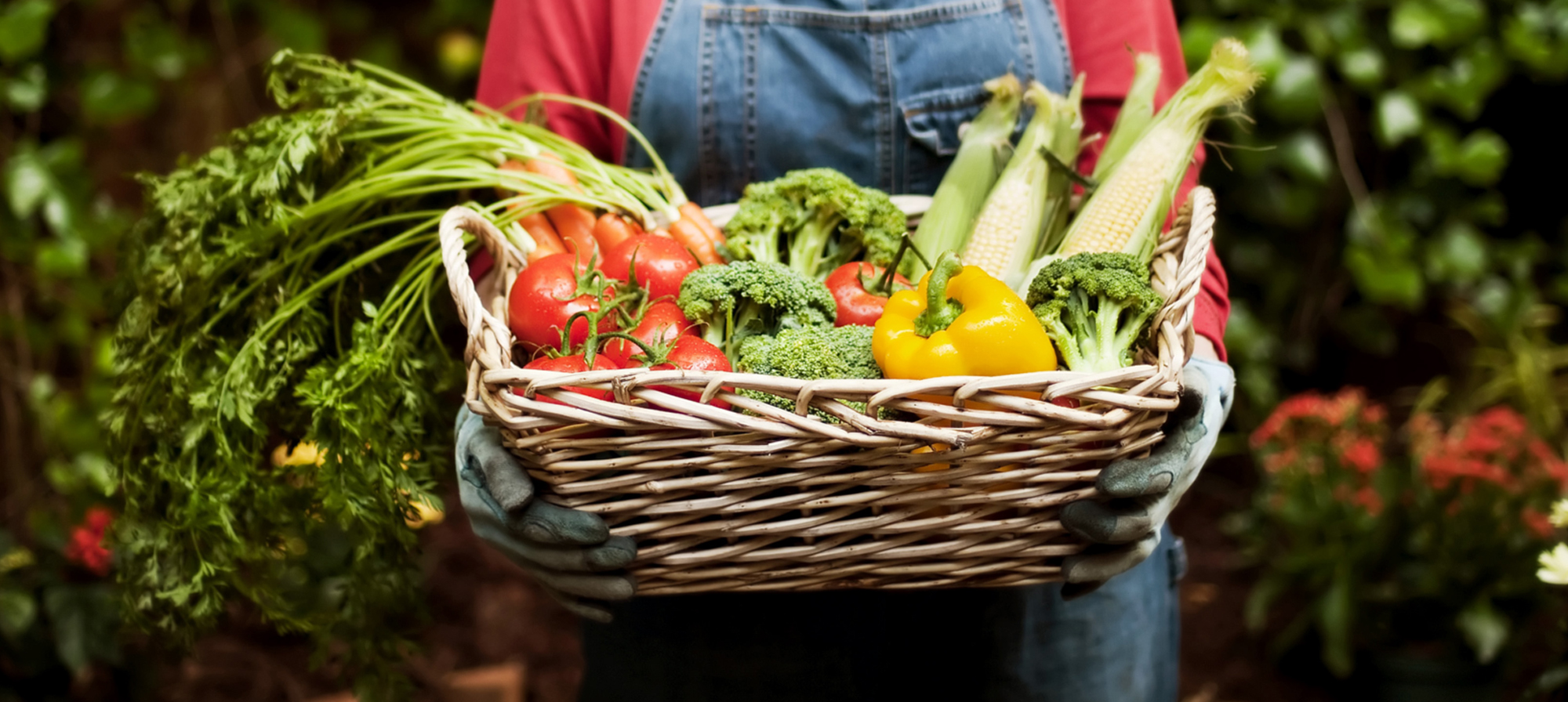Sustainable eating is better for the environment and healthier for you. And it's not as costly or complicated as you might think. Learn what it means to eat sustainably, and how to do more of it.
Sustainable eating is a fairly new way of eating that is uniting generations, regions, and cultures around one simple, elegant idea:
When you know where your food comes from, how it’s produced, and how it’s shipped, you have the power to choose higher-quality, nutrient-rich foods whose production causes less stress to the environment.
Better for you, better for the planet. A double win, right? Yet, for all its potentially epic benefits, this food plan also is a surprisingly affordable and enjoyable way to eat and live. Here’s a closer look at some of the ways you might adopt sustainable eating.
 Shop for locally grown produce.
Shop for locally grown produce.
Locally grown, seasonal fruits and veggies are just that: local. That means they don’t have to be shipped in from far away. That also means fewer greenhouse gases are released when moving them from farm to market to plate. Plus, produce tends to be fresher and, therefore, have more of its nutrients intact when grown nearby and not shipped over long distances.
Think about shopping at your local farmers market, if you have one in your town. Growers at farmers markets tend to have farms in the area. And you’ll be able to meet and talk with the farmers, too. They can tell you how your food was grown and when it was harvested. And they may have tips for how to store and prepare your produce. If you don’t have a farmers market in your area, ask your grocer if any of their produce is grown locally. You can also ask grocers and restaurants in your town to buy more of their produce from local farms.
The other key step is to eat produce that’s in season—at least, as much as you can. Say you live in Illinois. If you see fresh strawberries at your local grocery store in February, those were likely not grown anywhere nearby.
Check out this handy seasonal produce guide before you make your next shopping list.
 Eat a little less meat.
Eat a little less meat.
While the ultimate health impact of eating a diet high in meat, dairy, and eggs is still being researched, some studies have found that a whole-foods, plant-based diet supports good blood pressure, heart health, healthy weight, and more. And there’s no question that shifting to more plant-based foods can help protect the planet. Raising livestock takes much more water, energy, and land than raising food crops. It also emits more planet-warming greenhouse gases.
But you don’t have to give up meat altogether to boost your health and protect the environment. All it takes is a small shift to a more plant-centric food plan. One that includes more whole fruits and veggies, grains, beans and legumes, and nuts and seeds. You can easily get all the protein you need with these foods.
Meat lover? Here’s how you can eat a plant-based diet without giving up meat.
You might start by eating smaller portions of meat, dairy, and eggs with each meal. One way to do this is to make vegetables the main course, and meat the side dish. Or you might eat meat for only 2 to 3 meals a week and make plant-based meals the rest of the time.
There are many other small steps you can take with this type of sustainable eating:
- Cook with olive oil and other vegetable or nut oils instead of butter or animal fat.
- Try a bean burrito instead of sausage and eggs one morning.
- Sprinkle nuts and seeds on your salad instead of bacon bits and cheese.
- You can also search for new and tasty plant-based recipes online and open yourself to a host of flavorful and nutritious meals.
 Choose your seafood wisely.
Choose your seafood wisely.
Many types of ocean fish are being depleted by overfishing. This is because some types of fish are being taken from the ocean faster than they can reproduce. Some government groups have put seafood management plans in place to help solve this problem. But you can do your part by choosing seafood that’s not being overfished.
Use this search tool to help you make sustainable seafood choices.
 Curb food waste.
Curb food waste.
The EPA estimates that about 66 million tons of food end up in landfills each year. We throw out about 25% of the food we buy. Cutting that waste can save money, energy, and the plastic and paper that go into packaging. It would also lower methane emissions from landfills.
Plan your meals carefully. Only put the ingredients and amounts you’ll need on your shopping list. Be sure any fresh food you buy will be eaten within 3 to 5 days. Store your produce in ways that help it last longer. Make meals and freeze them if you can’t eat them right away. Go through your cupboard once a month or so and donate any canned goods, grains, or pasta you know you aren’t going to eat. Just check the “best by” date first.
Try to be more mindful when you plan, shop for, prep, and eat your meals. Slow down when eating and focus on your food and how it smells and tastes. Think about where it came from and all the nutrients it is giving your body. Notice when you’re feeling full and stop eating. Save the leftovers for another meal. In time, you may realize you need less food than you’ve been buying. This may help you cut your shopping list, save money, eat fewer calories, and waste less food.
 Drink from the tap.
Drink from the tap.
If you buy bottled water or have it shipped to your home, consider installing a water filtration unit instead. You’ll save a ton of money over time. But it’s also a great way to cut back on single-use plastic bottles. That also means fewer water delivery trucks emitting greenhouse gases.
 Buy fewer packaged foods.
Buy fewer packaged foods.
You’ve likely heard about all the plastic choking the oceans. Think about cutting back on packaged foods and buying more often from the bulk section instead. This will help cut back on paper and plastic waste. Eating bulk versus packaged foods takes less water and energy, too. Many packaged foods are often high in salt, fat, or added sugars. Whole cereals, beans, nuts, and seeds from the bulk section tend to be lower in these unhealthy ingredients and higher in nutrients.
When you head to the bulk section you can also bring your own reusable canvas, paper, or fine mesh bags. You can also use these in the produce section and for bagging your groceries. This will help cut down on single-use plastic bags that end up in the landfill or ocean.
As the world’s human population keeps growing, the importance of sustainable eating will grow with it. Experts say that making a global shift to this way of eating can help curb world hunger, malnutrition, poor health, and environmental harm. Doing so will help ensure that future generations can produce food that is healthy for the planet and all its inhabitants.
Not a Silver&Fit® member? Learn more about everything the program has to offer, including more helpful healthy living tips like this, here on our website.
This information is not intended to take the place of regular medical care or advice. Please check with your doctor before using this information or beginning any self-care program. Images used for this article do not depict any members of the Silver&Fit program.
References
Academy of Nutrition and Dietetics. (2024, January 2). Sustainable eating. https://www.eatright.org/health/lifestyle/culture-and-traditions/sustainable-eating#:~:text=Sustainable%20eating%20is%20about%20choosing,a%20nutritious%20and%20sustainable%20diet
Aleksandrowicz, L., Green, R., Joy, E.J.M., Smith, P., Haines, A. (2016). The impacts of dietary change on greenhouse gas emissions, land use, water use, and health: A systematic review. PLoS One. 11, e0165797.
American Heart Association. (2023, December 20). How does plant-forward (plant-based) eating benefit your health? https://www.heart.org/en/healthy-living/healthy-eating/eat-smart/nutrition-basics/how-does-plant-forward-eating-benefit-your-health
Harvard T.H. Chan School of Public Health. (2015, June 17). 5 tips for sustainable eating. https://www.hsph.harvard.edu/nutritionsource/2015/06/17/5-tips-for-sustainable-eating/
Harvard Health Publishing. (2020, February 1). What’s the beef with red meat? https://www.health.harvard.edu/staying-healthy/whats-the-beef-with-red-meat
Kahleova, H., Levin, S., & Barnard, N. (2017). Cardio-metabolic benefits of plant-based diets. Nutrients, 9(8), pii, E848. https://doi:10.3390/nu9080848
Mayo Clinic. (2022, December 9). Meatless meals: The benefits of eating less meat. https://www.mayoclinic.org/healthy-lifestyle/nutrition-and-healthy-eating/in-depth/meatless-meals/art-20048193
Medawar, E., Enzenbach, C., Roehr, S., Villringer, A., Riedel-Heller, S. G., & Witte, A. V. (2020). Less animal-based food, better weight status: Associations of the restriction of animal-based product intake with body-mass-index, depressive symptoms and personality in the general population. Nutrients, 12(5), 1492. https://doi:10.3390/nu12051492
National Oceanic and Atmospheric Administration. (n.d.) Understanding sustainable seafood. https://www.fisheries.noaa.gov/insight/understanding-sustainable-seafood
Poore, J., Nemecek T. (2018). Reducing food’s environmental impacts through producers and consumers. Science, 360(6392),987-992. https://doi:10.1126/science.aaq0216
Patel, H., Chandra, S., Alexander, S., Soble, J., & Williams, K. A., Sr. (2017). Plant-based nutrition: An essential component of cardiovascular disease prevention and management. Current Cardiology Reports, 19(10), 104. https://doi:10.1007/s11886-017-0909-z
Satija, A., Bhupathiraju, S. N., Rimm, E. B., Spiegelman, D., Chiuve, S. E., Borgi, L., . . . Hu, F. B. (2016). Plant-based dietary patterns and incidence of type 2 diabetes in US men and women: Results from three prospective cohort studies. PLoS Medicine, 13(6), e1002039. https://doi:10.1371/journal.pmed.1002039
U.S. Environmental Protection Agency. (2024, September 26). Food: Material-specific data. https://www.epa.gov/facts-and-figures-about-materials-waste-and-recycling/food-material-specific-data#:~:text=EPA%20estimates%20that%20in%202019,beverage%20manufacturing%20and%20processing%20sectors.
U.S. Environmental Protection Agency. (2024, September 27). Reducing wasted food at home. https://www.epa.gov/recycle/reducing-wasted-food-home
Willett, W., Rockström, J., Loken, B., Springmann, M., Lang, T., Vermeulen, S., Garnett, T., Tilman, D., DeClerck, F., Wood, A., Jonell, M., Clark, M., Gordon, L. J., Fanzo, J., Hawkes, C., Zurayk, R., Rivera, J. A., De Vries, W., Majele Sibanda, L., & Afshin, A. (2019). Food in the Anthropocene: the EAT–Lancet Commission on Healthy Diets from Sustainable Food Systems. The Lancet, 393(10170), 447–492. https://www.thelancet.com/journals/lancet/article/PIIS0140-6736(18)31788-4/abstract
World Health Organization. (2018, November). A healthy diet sustainably produced. https://apps.who.int/iris/bitstream/handle/10665/278948/WHO-NMH-NHD-18.12-eng.pdf?ua=1
This article was written by Gail Olson, edited by Jason Nielsen, and clinically reviewed by Elizabeth Thompson, MPH, RDN.





